Experimental Study and Numerical Simulation of an Electrical Preheating for SAGD Wells in Heavy Oil Reservoirs
Abstract
:1. Introduction
2. Experiments for the Heat Transfer of Wellbore Fluids
2.1. Experiments Materials
2.2. Experimental Apparatus
2.3. Experimental Procedures
- (1)
- Before the experiment, the sand wellbore was packed with quartz sand.
- (2)
- The wellbore was saturated with water under 5.82 MPa of pressure.
- (3)
- The heater’s surface temperature was set to 300 °C, and then the heater was turned on for 5 days.
- (4)
- The temperature changes detected by the 7 temperature measurement points in the sand pack were measured and calculated by temperature data acquisition equipment.
2.4. Results and Discussion
3. Numerical Simulation
4. Experiments for the Heating Characteristics of Actual Wellbore
4.1. Experimental Procedures
- (1)
- Before the experiment, the actual wellbore was packed with quartz sand.
- (2)
- The wellbore was saturated with water under 5.82 MPa of pressure, and the insulation layers outside the wellbore were set to 15 °C, 20 °C, 25 °C, and 30 °C.
- (3)
- The heater’s surface temperature was set to 300 °C, and then the heater was turned on for 100 h.
- (4)
- The temperature changes were measured by the 20 measurement points, and the average temperature was calculated by temperature data acquisition equipment.
4.2. Results and Discussion
5. Conclusions
- (1)
- The wellbore in the preheating stage was more suitable for saturation with water rather than heat-conduction oil or CO2. Even though the results of the physical experiments showed that the heat transfer performance of heat-conduction oil is the best, the thermal conductivity of water is second, and the thermal conductivity of CO2 is the worst. Therefore, after the heat-conduction oil was injected, the heating range of the heating rod in the sand-filling pipe is the widest. However, heat-conduction oil and water had a similar effect in reducing the viscosity of heavy oil near the well. According to the results of the numerical simulation experiment, when wellbores were saturated with water, the oil viscosity recovery between injection and production well was 89 mPa.s after preheating 300 days, which is similar to 85 mPa.s when wellbores were saturated with the heat-conduction oil. Because heat-conduction oil has a good ability to dissolve super-heavy oil, the super-heavy oil flowed into the wellbore due to the solubility of the heat-conduction oil and its own gravity. As a result, the super-heavy oil content in the wellbore gradually accumulated, increasing the risk of coking. The cumulative energy consumption of water injected into the wellbore was only 1.5% more than that of the heat-conduction oil injected into the wellbore. Therefore, the wellbore in the preheating stage was more suitable for saturated water rather than heat-conduction oil or CO2.
- (2)
- It took different heating times for the wellbore to reach 300 °C. The higher the foundation temperature was, the less time the wellbore took to reach 300°C. The wellbore heated up quickly in the initial stage. When the temperature reached 200 °C, the heating rate slowed down. The original reason was that the heat-transfer loss from the wellbore increased. After the wellbore was heated for 98 h, the wellbore temperature reached 300 °C. The total heating power was 2.698 KW; when the temperature of the wellbore reached 300 °C, the total power required to maintain the temperature dropped to 1.868 kW, which was 69.2% of the initial power.
Author Contributions
Funding
Institutional Review Board Statement
Data Availability Statement
Acknowledgments
Conflicts of Interest
References
- Liu, P.; Zhou, Y.; Liu, P.; Shi, L.; Li, X.; Li, L. Numerical study of herringbone injector -horizontal producer steam assisted gravity drainage (HI-SAGD) for extra-heavy oil recovery. J. Pet. Sci. Eng. 2019, 181, 106227. [Google Scholar] [CrossRef]
- Yuan, Z.; Liu, P.; Zhang, S.; Jiao, Y.; Li, X. Experimental study and numerical simulation of a solvent-assisted start-up for SAGD wells in heavy oil reservoirs. J. Pet. Sci. Eng. 2017, 125, 261–268. [Google Scholar] [CrossRef]
- Hill, D.G.; Chilingar, G.V.; Wittle, J.K. Direct current electrical enhanced oil recovery in heavy-oil reservoirs to improve recovery, reduce water cut, and reduce H2S production while increasing API gravity. In Proceedings of the SPE 114012, Egional and Pacific Section AAPG Joint Meeting, Bakersfield, CA, USA, 29 March–2 April 2008. [Google Scholar]
- Okassa, F.; Godi, A.; de Simoni, M.; Matteo, M.; Misenta, M.; Maddinelli, G. A nonconventional EOR technology using RF/MW heating coupled with a new patented well/reservoir interface. In Proceedings of the SPE 134324: SPE Annual Technical Conference and Exhibition, Florence, Italy, 19–22 September 2010. [Google Scholar]
- Gasbarri, S.; Diaz, A.; Guzman, M. Evaluation of electric heating on recovery factors in extra heavy oil reservoirs. In Proceedings of the SPE 149779: SPE Heavy Oil Conference and Exhibition, Kuwait City, Kuwait, 12–14 December 2011. [Google Scholar]
- Peraser, V.; Patil, S.L.; Khataniar, S.; Dandekar, A.Y.; Sonwalkar, V.S. Evaluation of electromagnetic heating for heavy oil recovery from alaskan reservoirs. In Proceedings of the SPE 154123: SPE Western Regional Meeting, Bakersfield, CA, USA, 21–23 March 2012. [Google Scholar]
- Parmar, G.; Zhao, L.; Graham, J. Start-up of SAGD wells: History match, wellbore design and operation. J. Can. Pet. Technol. 2009, 48, 42–48. [Google Scholar] [CrossRef]
- Ma, M.; Faradonbeh, M.R.; Hassanzadeh, H.; Harding, T.G.; Zanon, S. Comparative study of SAGD and solvent and water sssisted wlectrical heating: Effect of shale layers. In Proceedings of the SPE 184997: SPE Canada Heavy Oil Technical Conference, Calgary, AB, Canada, 15–16 February 2017. [Google Scholar]
- Shi, L.; Li, X.; Xi, C.; Qi, Z.; Liu, P. Analytical modeling of the oil steam ratio during the lifetime steam-assisted gravity drainage process in extra-heavy oil reservoirs. J. Pet. Sci. Eng. 2021, 203, 108616. [Google Scholar] [CrossRef]
- Guo, E.; Jiang, Y.; Gao, Y.; Shen, D.; Zhigang, C.; Yu, P. A new approach to improve recovery efficiency of SAGD. In Proceedings of the SPE 183741: SPE Middle East Oil & Gas Show and Conference, Manama, Bahrain, 6–9 March 2017. [Google Scholar]
- Kumar, A.; Hassanzaden, H. Impact of shale barriers on performance of SAGD and ES-SAGD—A review. Fuel 2021, 289, 119850. [Google Scholar] [CrossRef]
- Wang, Z.; Gao, D.; Diao, B.; Tan, L.; Zhang, W.; Liu, K. Comparative performance of electric heater vs. RF heating for heavy oil recovery. Appl. Therm. Eng. 2019, 160, 105–114. [Google Scholar] [CrossRef]
- Hascakir, B.; Babadagli, T.; Akin, S. Field-scale analysis of heavy-oil recovery by electrical heating. SPE Reserv. Eval. Eng. 2010, 13, 131–142. [Google Scholar] [CrossRef]
- Zhong, L.; Yu, D.; Yang, H.; Sun, Y.; Wang, G.; Zheng, J. Feasibility study on produce heavy oil by gas and electrical heating assisted gravity drainage. In Proceedings of the SPE 174406: SPE Canada Heavy Oil Technical Conference, Calgary, AB, Canada, 9–11 June 2015. [Google Scholar]
- Zhu, Z.; Zeng, F. Evaluation of the hybrid process of electrical resistive heating and solvent injection through numerical smulations. In Proceedings of the SPE Heavy Oil Conference Canada, Calgary, AB, Canada, 12–14 June 2012. [Google Scholar]
- Ghannadi, S.; Irani, M.; Chalaturnyk, R.J. Induction and radio frequency heating strategies for steam-assisted gravity drainage start-Up phase. In Proceedings of the SPE 170037: SPE Heavy Oil Conference-Canada, Calgary, AB, Canada, 10–12 June 2014. [Google Scholar]
- Bermúdez, J.; Acosta, W.; Andarcia, L.; Suarez, A.; Vaca, P.; Pasalic, D.; Okoniewski, M. Assisted extra heavy oil sampling by electromagnetic heating. In Proceedings of the SPE 171073: SPE Heavy and Extra Heavy Oil Conference, Latin America, Medellín, Colombia, 24–26 September 2014. [Google Scholar]
- Yuan, J.Y.; Huang, H.; Mintz, R.; Wang, X.; Jossy, C.; Tunney, C. Wet electric heating for starting up SAGD/VAPEX. In Proceedings of the Petroleum Society of Canada Canadian International Petroleum Conference, Calgary, AB, Canada, 1–3 August 2004. [Google Scholar]
- Vermeulen, F.E.; Chute, F.S.; McPherson, R.G. Physical modelling of electrothermal processes in oil sand. Alta. Oil Sands Technol. Res. J. Res. 1988, 4, 299–305. [Google Scholar]
- Xi, C.; Qi, Z.; Jiang, Y.; Han, W.; Shi, L.; Li, X.; Wang, H.; Zhou, Y.; Liu, T.; Du, X. Dual-horizontal wells SAGD start-up technology: From conventional steam circulation to rapid and uniform electric heating technology. In Proceedings of the SPE 189241: SPE Symposium: Production Enhancement and Cost Optimisation, Kuala Lumpur, Malaysia, 7–8 November 2017. [Google Scholar]
- Nasr, T.N.; Beaulieu, G.; Golbeck, H.; Heck, G. Novel expanding solvent-SAGD process “ES-SAGD”. J. Can. Pet. Technol. 2003, 42, 13–16. [Google Scholar] [CrossRef]
- Rafiee, M.; Behr, A.; Lessner, E.; Diehl, D.; Trautmann, B.; Koch, A. Electromagnetic Heating for Heavy Oil Production: Case Study of a Field Applicability. In Proceedings of the SPE Russian Petroleum Technology Conference, Moscow, Russia, 26–28 October 2015. [Google Scholar]
- Ramcharan, T.; Hosein, R.; Jupiter, A. The Viability of oil extraction from trinidad tar sands by radio frequency heating-a simulation approach. In Proceedings of the SPE 180830: SPE Trinidad and Tobago Section Energy Resources Conference, Port of Spain, Trinidad and Tobago, 13–15 June 2016. [Google Scholar]
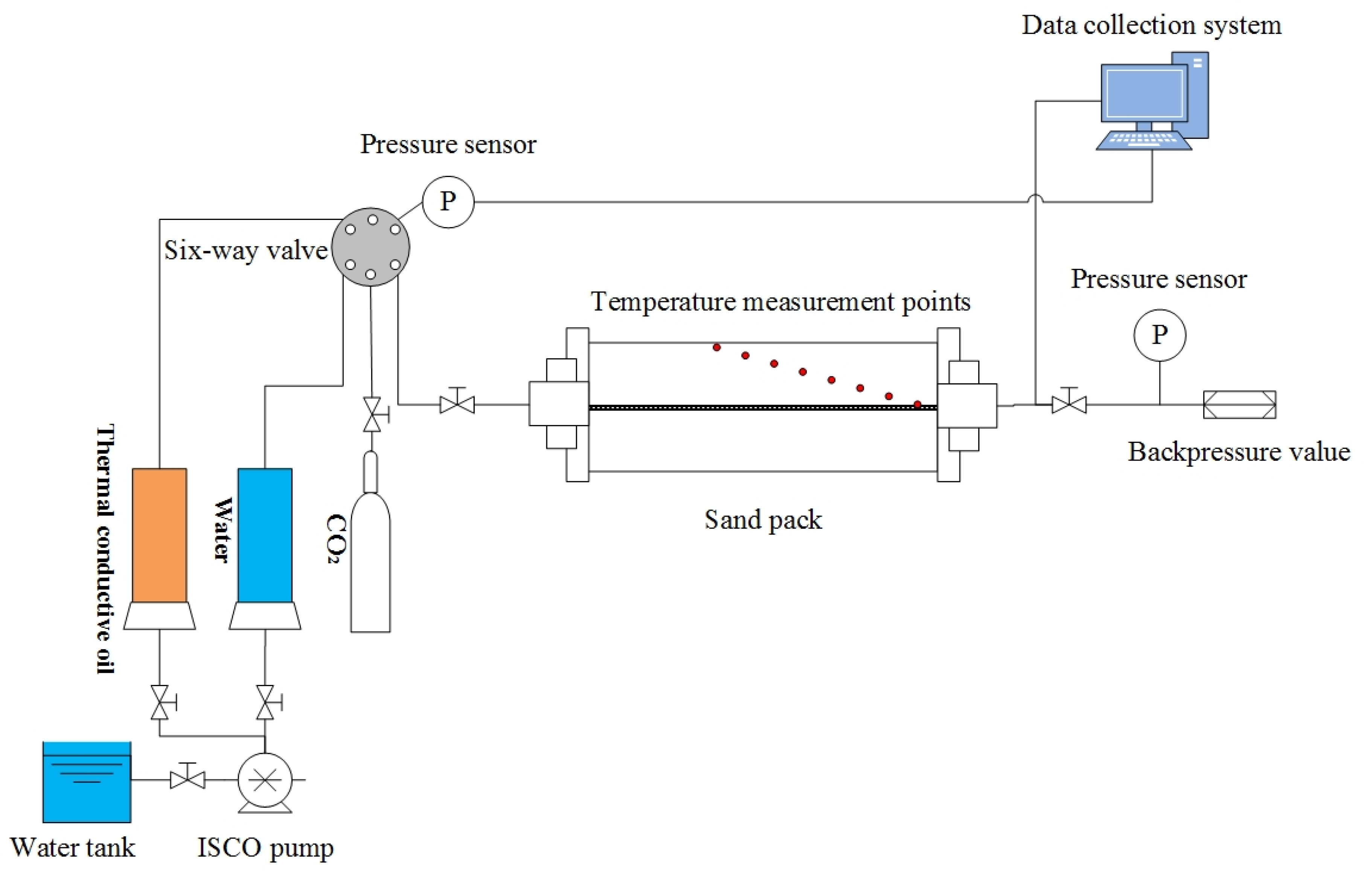


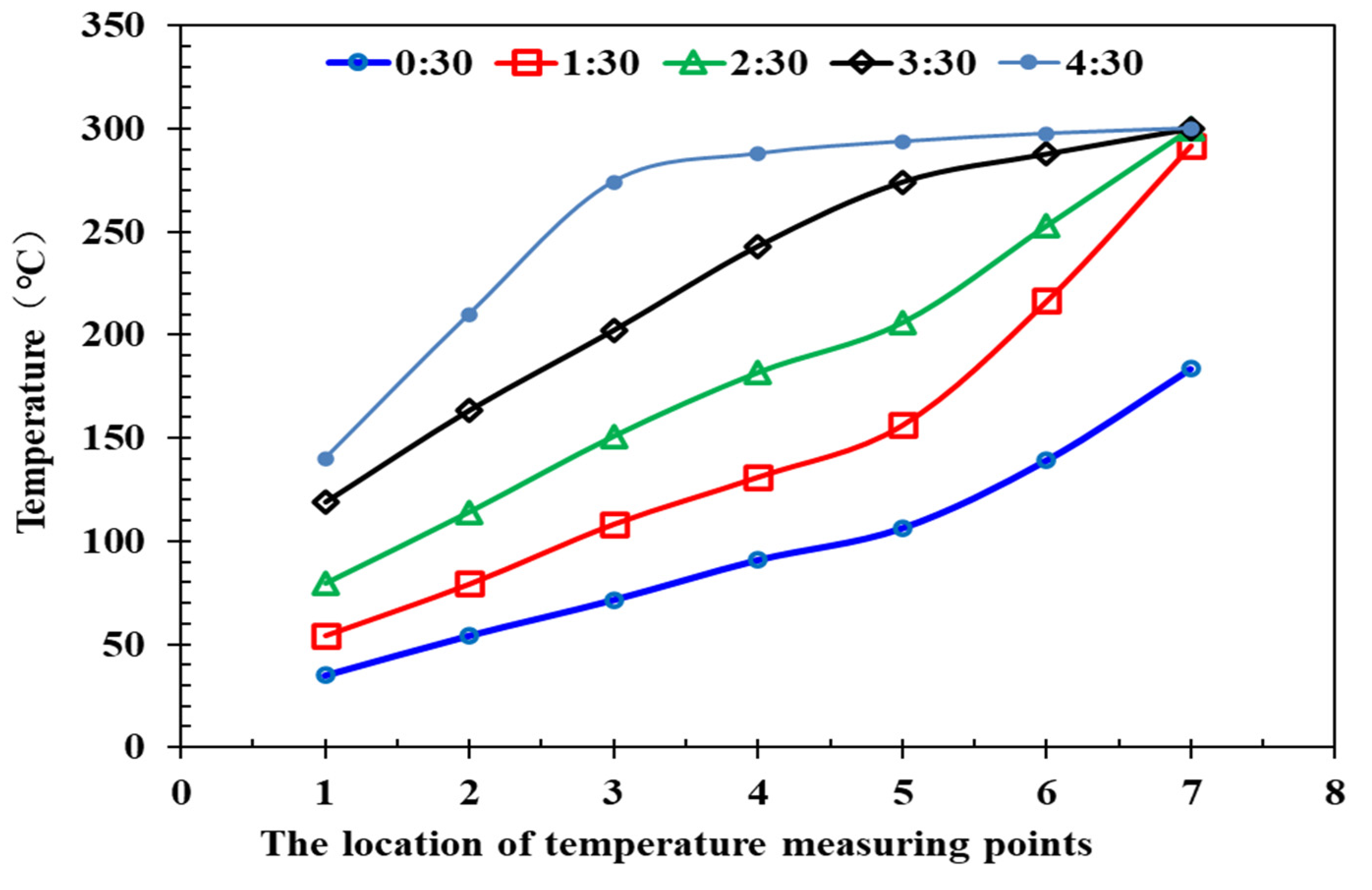
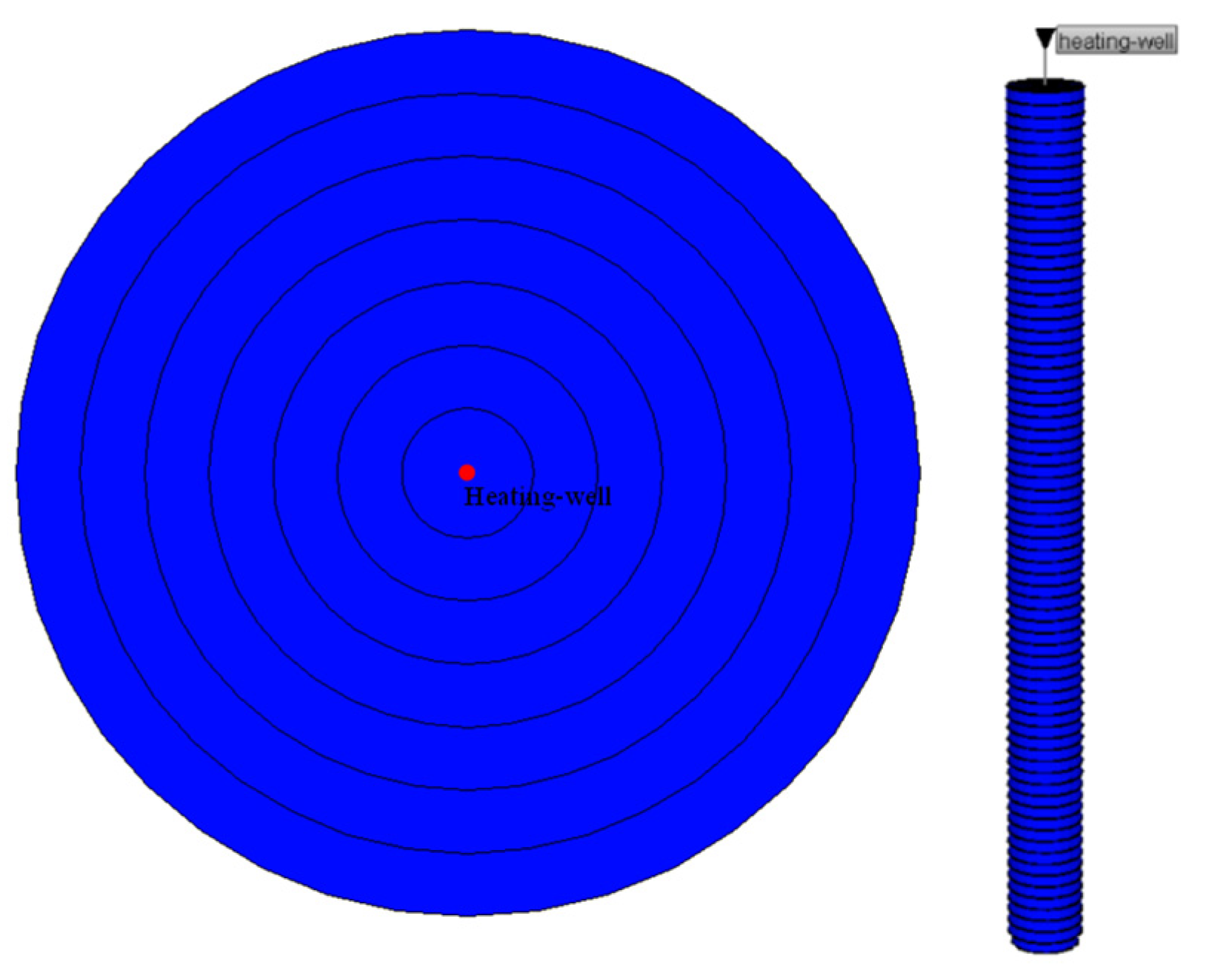



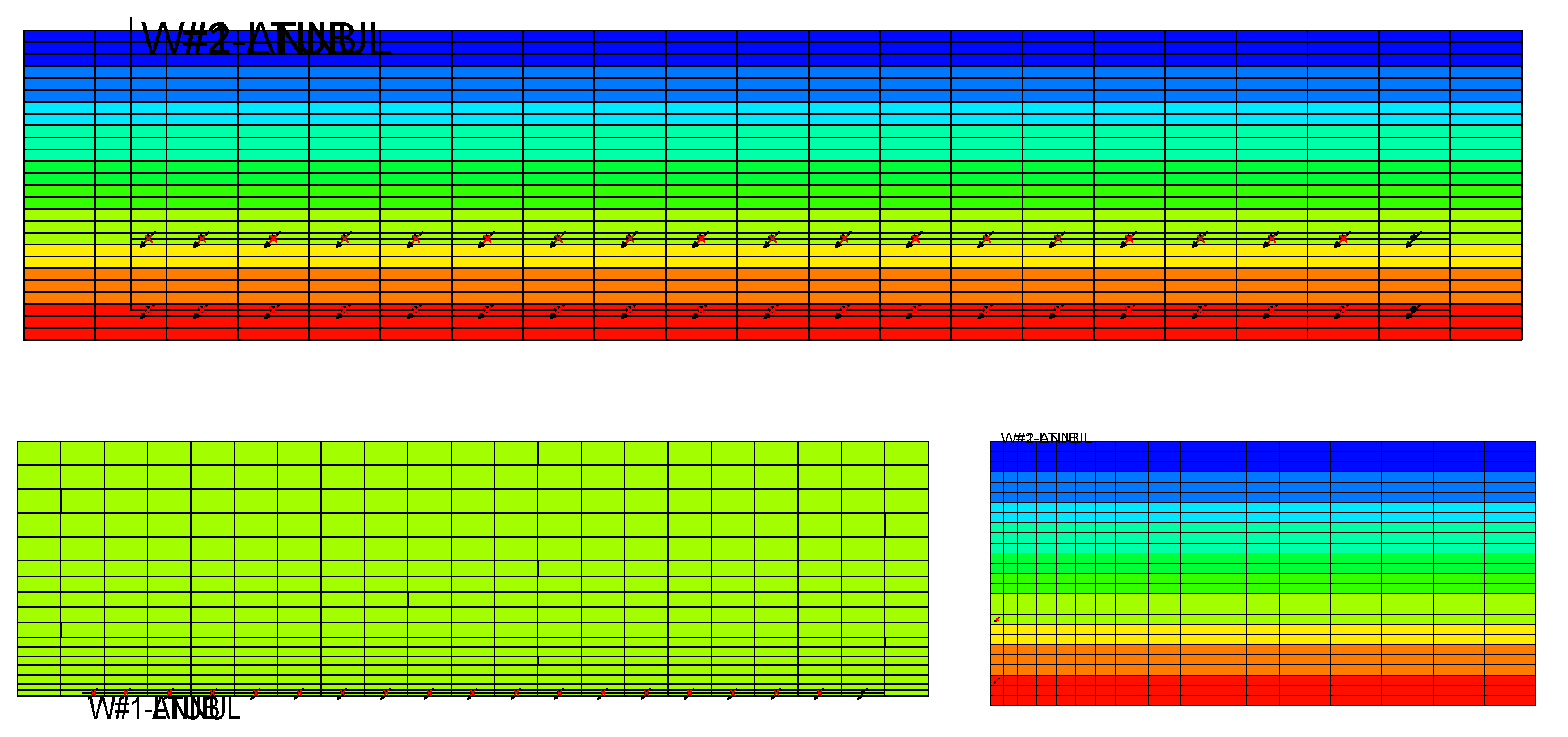
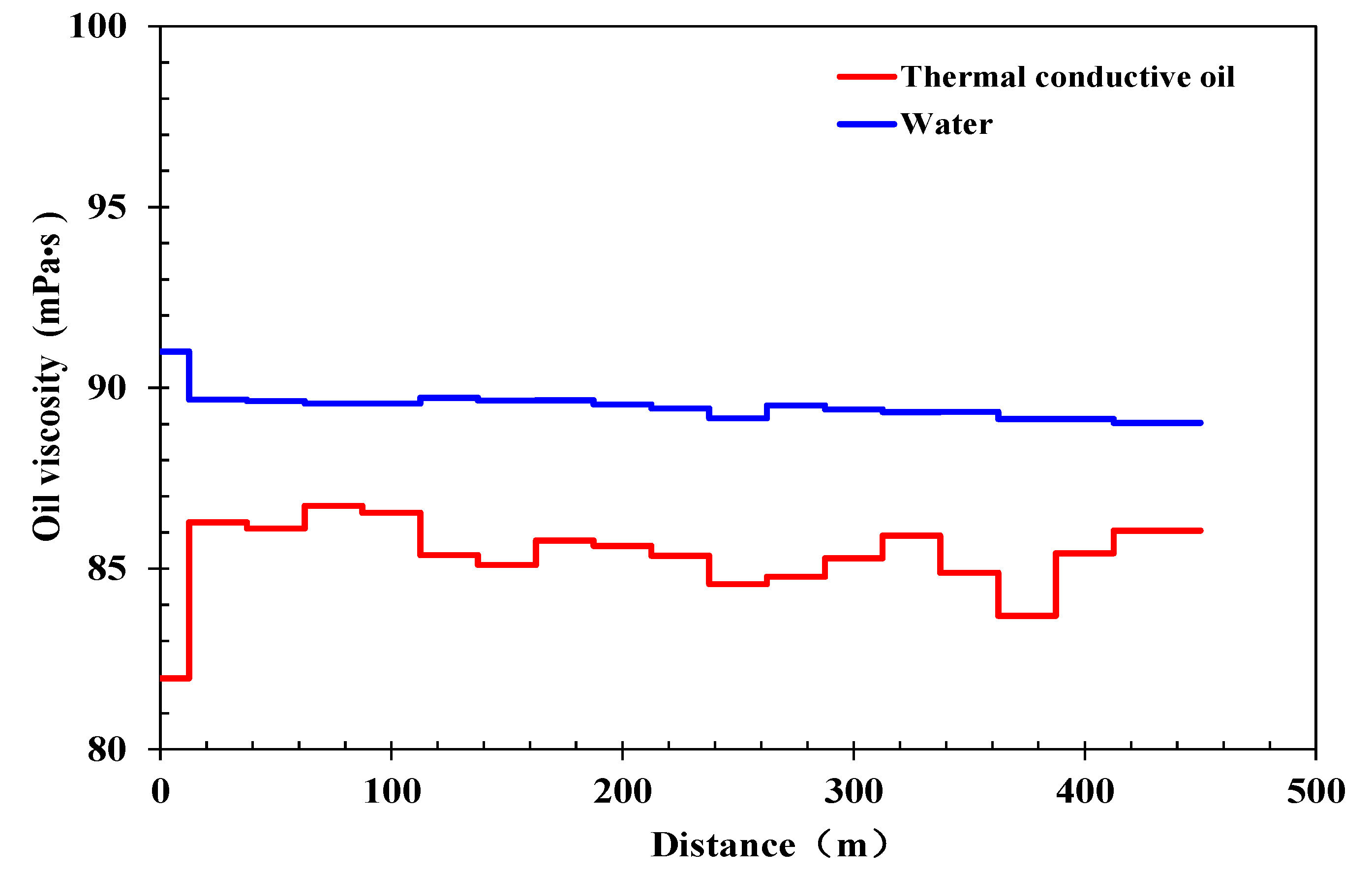
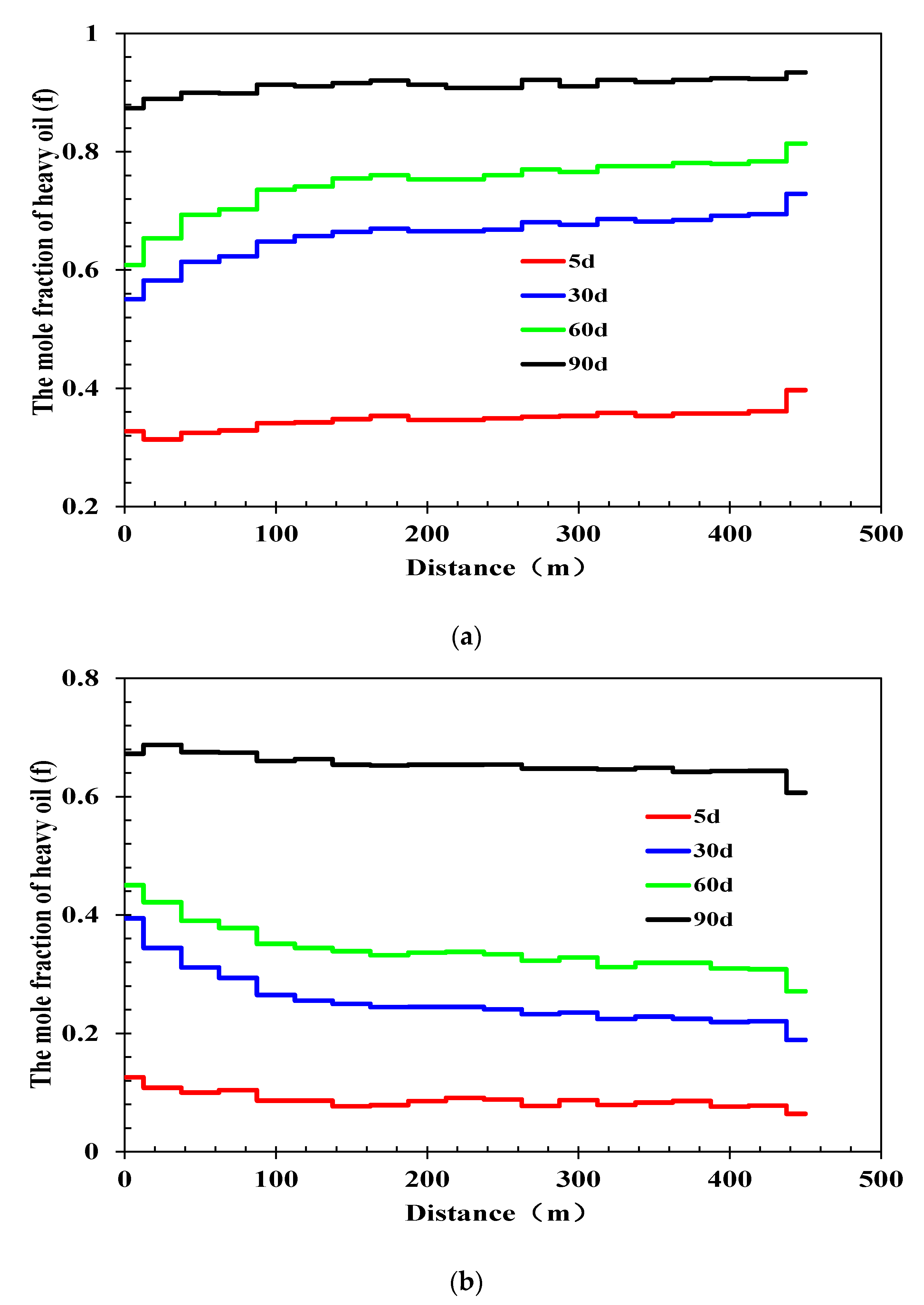


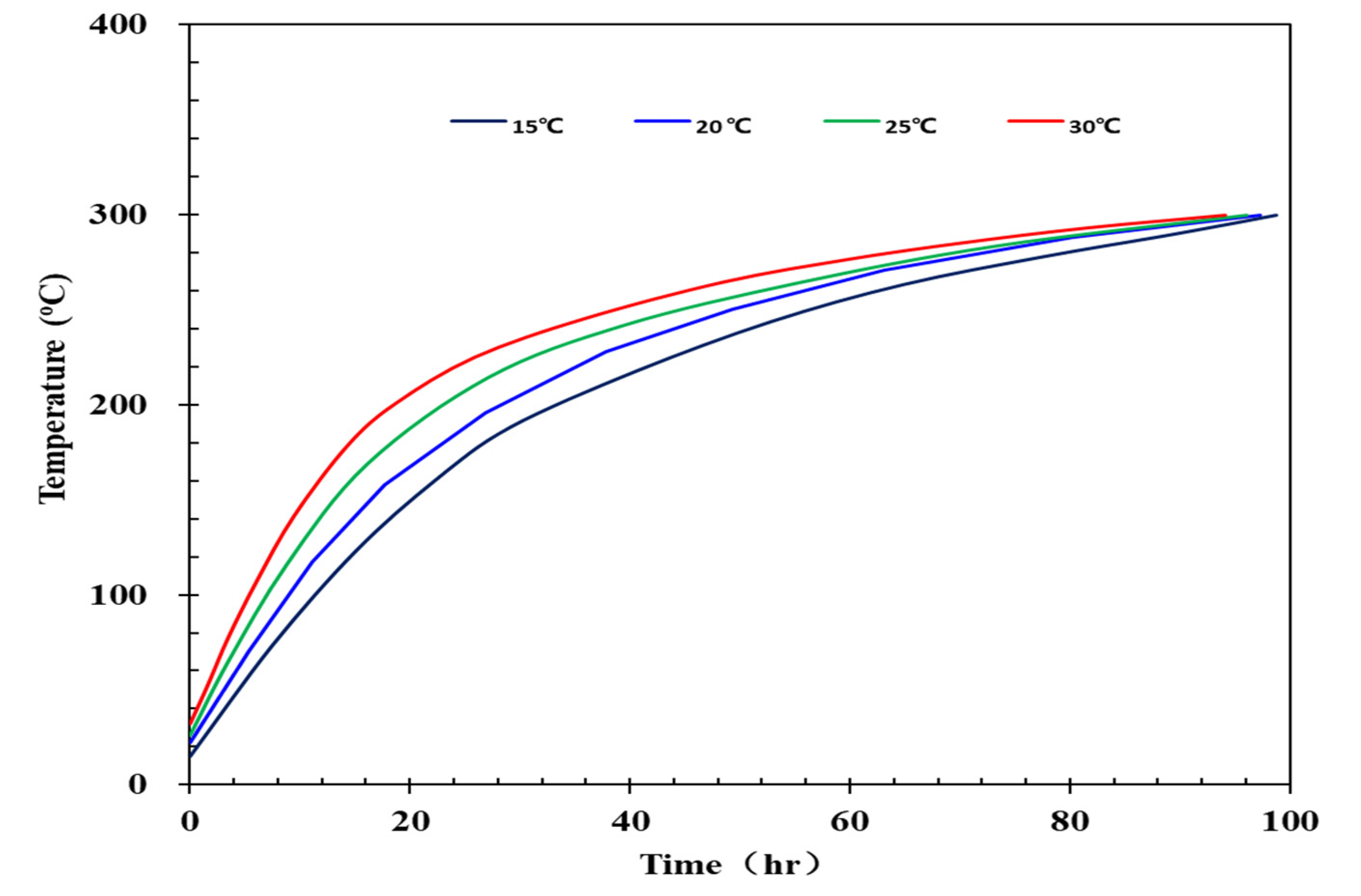
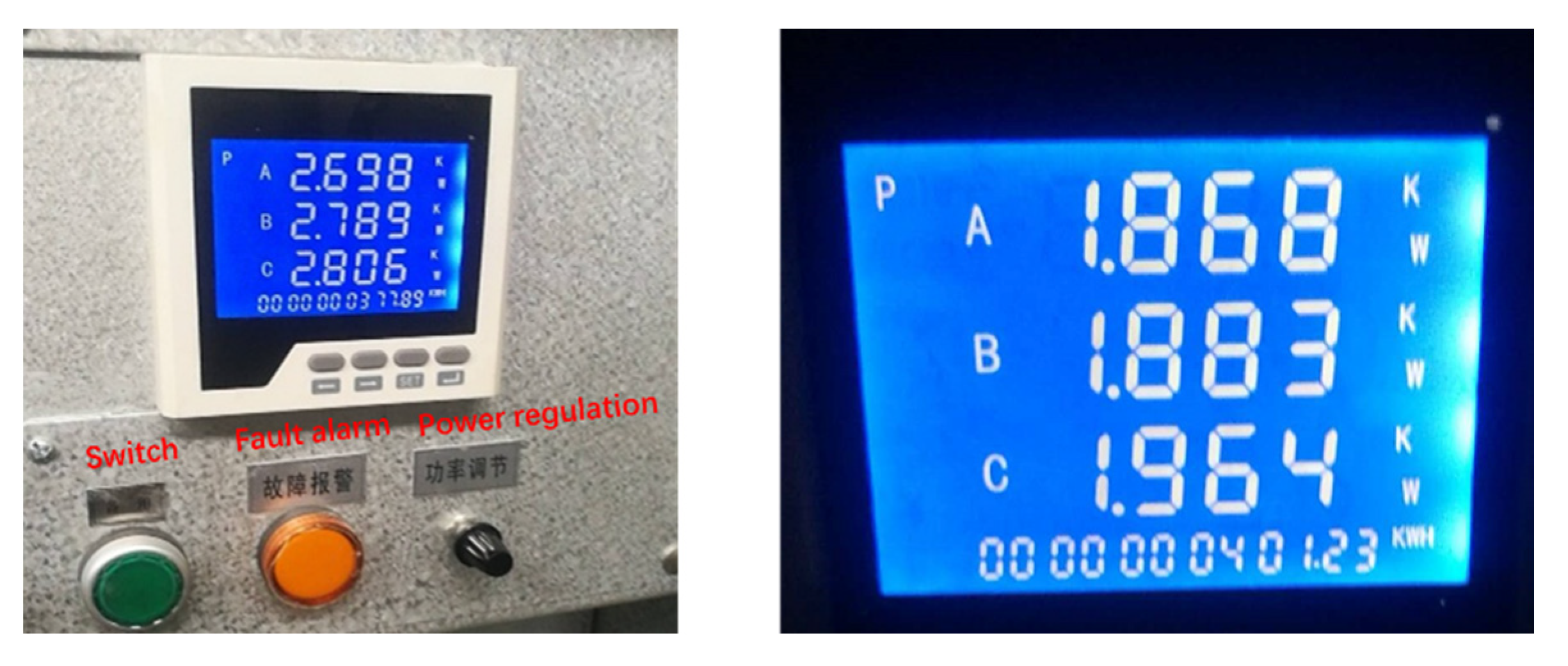
| Component | Thermal Conductivity |
|---|---|
| CO2 | 1.40 × 102 |
| Water | 1.15 × 104 |
| Heat-conduction oil | 5.35 × 104 |
| Grid Number, / | 7 × 1 × 80 | Radial Mesh Width, cm | 2.54 |
|---|---|---|---|
| Grid height, cm | 1.00 | Original formation pressure | 5.82 |
| Formation Temperature, °C | 20 | Porosity, f | 0.3 |
| Permeability, mD | 2000 | Oil saturation, f | 0.7 |
| Top Depth, m | 300.0 | Oil Viscosity (@50 °C), mPa·s | 9 × 104 |
|---|---|---|---|
| Thickness, m | 46.0 | Permeability, μm2 | 3.2 |
| Formation pressure, MPa | 3.0 | Porosity, f | 0.3 |
| Temperature, °C | 30.0 | Oil saturation, f | 0.7 |
Publisher’s Note: MDPI stays neutral with regard to jurisdictional claims in published maps and institutional affiliations. |
© 2022 by the authors. Licensee MDPI, Basel, Switzerland. This article is an open access article distributed under the terms and conditions of the Creative Commons Attribution (CC BY) license (https://creativecommons.org/licenses/by/4.0/).
Share and Cite
Wang, C.; Wu, Y.; Luo, C.; Jiang, Y.; Zhang, Y.; Zheng, H.; Wang, Q.; Zhang, J. Experimental Study and Numerical Simulation of an Electrical Preheating for SAGD Wells in Heavy Oil Reservoirs. Energies 2022, 15, 6102. https://doi.org/10.3390/en15176102
Wang C, Wu Y, Luo C, Jiang Y, Zhang Y, Zheng H, Wang Q, Zhang J. Experimental Study and Numerical Simulation of an Electrical Preheating for SAGD Wells in Heavy Oil Reservoirs. Energies. 2022; 15(17):6102. https://doi.org/10.3390/en15176102
Chicago/Turabian StyleWang, Chao, Yongbin Wu, Chihui Luo, Youwei Jiang, Yunjun Zhang, Haoran Zheng, Qiang Wang, and Jipeng Zhang. 2022. "Experimental Study and Numerical Simulation of an Electrical Preheating for SAGD Wells in Heavy Oil Reservoirs" Energies 15, no. 17: 6102. https://doi.org/10.3390/en15176102





